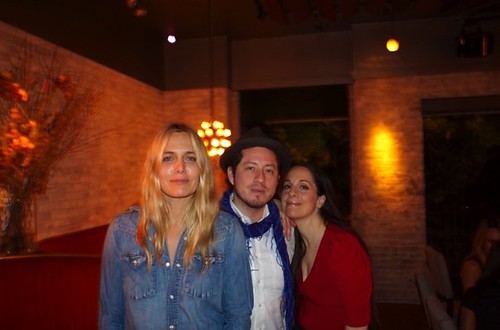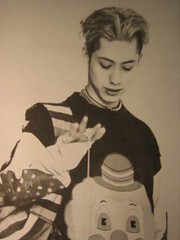Earlier today we reviewed “Limelight,” a film about the travails of club king Peter Gatien, who owned Palladium on East 14th Street (now an NYU dorm). Now Angelo Fabara recounts manning the door at Mr. Gatien’s most infamous club, Limelight, when he was a 18-year-old NYU freshman.
I started working at Limelight in 1992 (my freshman year at NYU) after two promoters from Bay Ridge, Mark Anthony and Michael Francis, spotted me dancing at an afterhours at Tunnel. They invited me to hand in a weekly guest list and offered to pay a commission for every person I got into the club. Around the same time, another club promoter, Alan Sanctuary, who was transitioning from Goth parties to raves, saw something in me and paired me with Sidney Prawatyotin, to tend the VIP ropes to The Chapel in the back of Limelight. Sidney would later appear in “Kids” and was mutual friends with Chloe Sevigny, a regular on the scene. He now runs a downtown fashion PR agency. Soon enough, I became a regular doorperson manning the VIP ropes of the main room’s life-size House of Cards. It was as cool a job as a 18-year-old NYU journalism student could have.
I’ve always looked young for my age, and back then I was the youngest doorperson in the city. People loved being asked for ID by someone who looked all of fourteen. For the most part, I didn’t drink or do hard drugs. In fact I was so naïve that I didn’t know I was hanging out with people who were high on cocaine or ecstasy. I’d accept their invitation to follow them into the bathroom and then when they asked if I wanted cocaine, I’d say “no thanks,” leaving them feeling rather ridiculous.
Tom Buckley was the salt-and-pepper-haired door manager who was at the top of Limelight’s pyramid. He was the type who would have a few words with the police and they’d go away. He knew I could handle myself. “You’re a good kid,” he would always say.
That’s what most people said about me: “He’s such a good kid. He goes home and does his homework.” Maybe this is why I never got briefed on drug dealers, if that ever happened. I was just the kid who showed up, did the guest list very well, and got paid. I was never told, “That’s a drug dealer— don’t let him in.” But I knew that kids were showing up early to get high off Ecstasy punch— sometimes five hits worth. Back then, one pill was nothing. It was obvious there were in-house dealers, and smaller dealers were not appreciated. I heard some of them, in fact, were robbed by security, something I suspect still happens at clubs today.
Eventually I was sharing door duties at the outside main entrance, over four nights a week, with legends like Kenny Kenny, Ruben Sandwich (R.I.P.), Kate Harwood, Mary Frey, Richard Baran, Tobie Giddio, and others. One night Tobie said, “My friend Mick is coming to visit me. You should meet him.” It turned out to be Mick Jones from The Clash. I had no idea who he was at the time.
At the club’s height, around 1990, someone like Kate Harwood was paid $1,000 per night for dealing – often sternly and sometimes shrewdly – with the thousands of people clamoring to get in. I got $200 for a 5-hour shift. It was easy money, and an early lesson in sociology: I came into contact with personalities from all over the world, all from different social and economic castes. Some were self-entitled; others were happy to just come have a good time.
One night, after I didn’t let some bridge-and-tunnel types into the club (with good reason, it turned out), one of them spent three hours staring me down, saying he would get me once I got off work. Apparently I had ruined his night. Being stoic in these situations was part of the job — any show of emotion would make a person like this think he had psyched you out. But I couldn’t help but think this guy might be crazy enough to wait and follow me home.
 Courtesy of Angelo Fabara Left to right: Limelight door alumni Mary Frey, Angelo Fabara, and Tobie Giddio
Courtesy of Angelo Fabara Left to right: Limelight door alumni Mary Frey, Angelo Fabara, and Tobie GiddioAt that moment, I realized it wasn’t worth mimicking the megalomaniacal style of the Limelight’s more established rope-tenders, and I began practicing the sort of diplomacy that would send people away feeling good. Instead of saying “Sorry, you don’t look the part,” or “you’re wearing sneakers; can’t let you in,” I would say, “Hey, really sorry, but we’re at capacity. Try this other club, or come back in an hour.” I would always reward patience and humility at my door but never abuse or degrade people.
In front of the Limelight, I would occasionally see Peter Gatien show up with an entourage. He had no idea who I was, nor did I know much about him. I heard rumors of a downward spiral involving crack abuse, and because of that, I was scared to go near the guy. Despite my position of power, I was ultimately a fly on the wall, and it was obvious we would never have a connection.
There weren’t that many people that worked closely with Peter Gatien— just a handful of managers and general managers. He was way too far above the ravers to even register as a personality; he was feared by his staff and had sharks all around him at all times. He was a real nineties NYC club czar.
As I watched a screening of “Limelight” last night, the film struck me as a broad stroke about Peter Gatien and his legal battles, but because I wasn’t near the guy, I wasn’t all that interested. There were hundreds of thousands of people who went to the club and knew of a Peter Gatien but didn’t know anything about him. I was hoping the movie would recreate the spirit of what Limelight was. Like anyone who went to the club, I wanted just five minutes of reliving my time there. It was special to many, many people. The archival footage that was used in “Limelight” just didn’t do it justice. The film breaks down the myth of Peter Gatien and portrays him as a mortal person. But do people care now? I know I don’t.
Angelo Fabara, 37, is the co-owner of a development and design agency, Gelo Factory.




